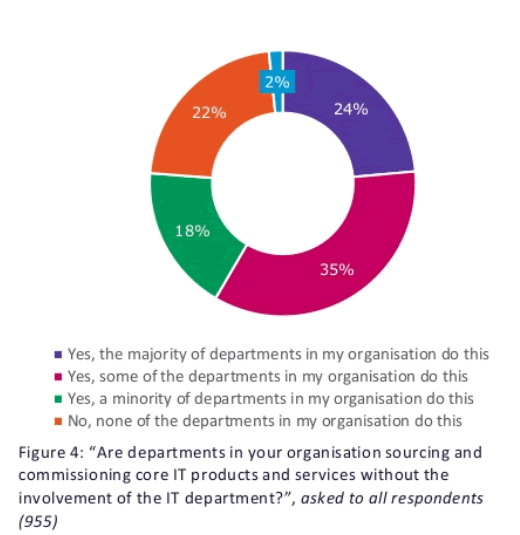How do you deal with shadow IT in your organization? It probably depends on the context. Shadow IT is not just a “thing” nor a matter for one department or business function. In the end, shadow IT has become an umbrella term for where IT investments are not done by IT but by other departments.
It also depends on the market reality of, for instance, vendors of specific IT solutions.
According to an IDC study (see image below) the two principal drivers of shadow IT (both were mentioned by 42% of respondents) in the enterprise are:
- the fact that IT suppliers increasingly target business users and
- the fact line-of-business heads demand higher velocity for IT projects.
Shadow IT isn’t going to go away as a phenomenon anytime soon. Surveys show that marketing executives, for instance, intend to increase their marketing technology spending in 2015. And marketing is far from the only department involved.
Shadow IT: what the CIO can do – and increasingly does

So, what’s a CIO to do? Increasingly there is a consensus we need to move towards a more ‘positive’ attitude regarding shadow IT. In a context where IT balances the availability of efficient IT infrastructures on one hand and transformation, innovation and business on the other, the call to embrace shadow IT instead of fighting it gets louder.
In that sense BT’s, Art of Connecting: Creativity and the modern CIO, is eye-opening. The research, based on a survey of almost 1,000 senior IT decision makers concludes that CIOs have “an unprecedented opportunity to take a leading role in their organizations, thanks in part to the rise of shadow IT.”
IT solutions, regardless of who purchases them, need to be secure, optimized and integrated. However, according to the research, many traditional hands-on tasks regarding the buying of IT solutions are shifting to the departments outside of the IT department. Knowing that, according to the study, shadow IT today accounts for a quarter of an organization’s IT spend and that 76% of CIOs see shadow IT within the business, there is probably no other solution than to empower these other departments. IT and the CIO can only do so many things and other departments only have limited patience or, as Marco Gianotten puts it “shadow IT is a chronic sign that getting things done by the IT department is just too much hassle”.
The CIO opportunity: shadow IT and the enablement of the digital business
Why is this an opportunity for the CIO? Moving away from hands-on support enables the CIO to focus on strategic roles in the areas that really need to be covered with security, governance and advice as key priorities.
Or in other words: it gives CIOs the opportunity to fulfill the expectations of getting increasingly closer to “the rest of the business” but also to gain a more important role in the organization and the board room in a digital business reality. And wasn’t that one of the challenges and probably even the core reason why we started coming up with new roles?
Whether the CIO will jump on the opportunity – or be allowed to – is of course a highly individual and contextual matter. But, in general, they can. As BT Global Services CEO Luis Alvarez said, “CIOs are perfectly placed to nurture creative uses of technology throughout their organisations while keeping a strategic view. Indeed, our research shows that the board expects nothing less.”
Sign of the times: almost six-in-ten respondents said the CIO has a much more central role in the boardroom compared with two years ago. And their KPIs have changed as well as you can read here.
So, shadow IT a threat or opportunity? It depends on the CIO and the organisation but the opportunities are clearly there.

This post was originally published on the BT Let’s Talk blog

